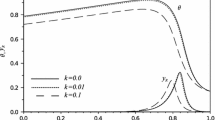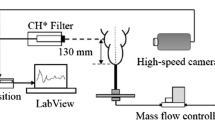Abstract
Qualitative transformation of a low-velocity laminar flow to a turbulent state (owing to natural or artificial instability) and formation of compression waves passing ahead have been studied in much detail. A disputable issue is the nature of the emergence of a reaction pocket in the region between the bow compression wave and the flame front moving at a certain distance behind this wave, as well as the dynamics of interaction of this pocket with the main structural elements. It is the type of this pocket (slow or explosive combustion) that defines its subsequent interaction with the compression wave front: shockless or shock-induced expansion capable of forming a detonation wave. As a method of transforming the reaction pocket to an explosion pocket, its amplification owing to the resonance of streamwise acoustic oscillations of hot reaction products with the initial combustible mixture induced by flame propagation is discussed. It is the resonance with its multiple enhancement of the amplitude of gas-dynamic parameters that can effectively initiate the deflagration-to-detonation transition. Various stages of this transition are discussed; the corresponding estimates are made and are found to be consistent with experiments.





Similar content being viewed by others
REFERENCES
V. A. Mikhelson, “On the Normal Velocity of Ignition of Explosive Gas Mixtures," Uch. Zap. Imper. Mosk. Univ. Otd. Fiz.-Mat., No. 10 (Universitet. Tipografiya, Moscow, 1893) [in Russian].
K. I. Shchelkin and Ya. K. Troshin, Gas Dynamics of Combustion (Izd. Akad. Nauk SSSR, Moscow, 1963) [in Russian].
Ya. B. Zel’dovich and D. A. Frank-Kamenetskii, Theory of Thermal Propagation of the Flame (Nauka, Moscow, 1981) [in Russian].
J. Warnatz, U. Maas, and R. W. Dibble, Combustion: Physical and Chemical Fundamentals, Modeling and Simulation, Experiments, Pollutant Formation (Springer, Berlin, 1996).
N. M. Bazhun, V. A. Ivanchenko, and V. N. Parmon, Thermodynamics of Chemists (Khimiya–KolosS, Moscow, 2004) [in Russian].
D. V. Sivukhin, General Course of Physics, Vol. II: Thermodynamics and Molecular Physics (Nauka, Moscow, 1975) [in Russian].
Physics of Explosion, Ed. by L. P. Orlenko (Fizmatlit, Moscow, 2002) [in Russian].
A. A. Vasil’ev, “Cellular Structures of a Multifront Detonation Wave and Initiation (Review)," Fiz. Goreniya Vzryva 51 (1), 9–30 (2015) [Combust., Expl., Shock Waves 51 (1), 1–20 (2015); DOI: 10.1134/S0010508215010013].
Tables of Physical Quantities: Reference Book, Ed. by I. K. Kikoin (Atomizdat, Moscow, 1976) [in Russian].
L. D. Landau, “To the Theory of Slow Combustion," Zh. Eksp. Teor. Fiz. 14 (6), 240–244 (1944).
K. P. Stanyukovich, Unsteady Motion of Continuous Media (Nauka, Moscow, 1971) [in Russian].
Author information
Authors and Affiliations
Corresponding author
Additional information
Translated from Fizika Goreniya i Vzryva, 2022, Vol. 58, No. 3, pp. 71-79.https://doi.org/10.15372/FGV20220307.
Rights and permissions
About this article
Cite this article
Vasil’ev, A.A. Resonance of Oscillations between the Reaction Products and Initial Mixture As a Reason for the Deflagration-to-Detonation Transition. Combust Explos Shock Waves 58, 318–326 (2022). https://doi.org/10.1134/S0010508222030078
Received:
Revised:
Accepted:
Published:
Issue Date:
DOI: https://doi.org/10.1134/S0010508222030078




